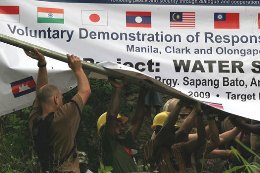 SAPANG BATO, May 12, 2009 - Representatives from four countries teamed up to improve the infrastructure and water supply here in early May as part of the 2009 Association of Southeast Asian Nations Regional Forum Voluntary Demonstration of Response on Disaster Relief. SAPANG BATO, May 12, 2009 - Representatives from four countries teamed up to improve the infrastructure and water supply here in early May as part of the 2009 Association of Southeast Asian Nations Regional Forum Voluntary Demonstration of Response on Disaster Relief.
The ARF-VDR is an activity designed to prepare international civilian humanitarian assistance and military teams to work together in the event of a natural disaster or other crises that impact the health and safety of the population.
This location has the greatest need in the area, said Philippines army 1st Lt. Amorito Saludez, the head of local engineering projects. It is home to many Philippine natives displaced by the eruption of Mount Pinatubo in 1991. The disaster devastated the region and left thousands homeless.
"Many of these families lost everything in 1991. Now, more than 20 years later, communities are still struggling to rebuild," Lieutenant Saludez said.
The remote location is home to more than 4,000 people. Running through the center of the village, is a deep, wide creek that makes transportation to either side difficult. During the rainy season, the creek rises at a very rapid rate, leaving residents stranded on either side. In the life-threatening event of a typhoon or a tsunami, getting residents from one side to the other would be critical in order to ensure their safety and reliable access to medical care.
Engineers from the Philippines, Papua-New Guinea, Australia, the United States and civilian volunteers have been working diligently on the construction of a hanging footbridge to facilitate the crossing process. Through rain and scorching heat, they have worked together to design and build the bridge with natural disasters in mind, ensuring it could withstand the pressure of rough winds and rain.
"This is just an example of the great things we can do when countries work together and bring what they can to the table," Lieutenant Saludez said. "This community will really benefit from our combined efforts."
Also, to provide a cleaner, healtheir water supply for the local people, the engineering team is constructing a much-needed water purification system and a well.
"Health is a big concern in remote areas like this. Eliminating some of the factors that lead to poor health is a start," said Lt. Col. John Waite, the chief medical officer for 13th Air Force at Hickam Air Force Base, Hawaii.
The air component participation for this event was planned and organized by 13th Air Force officials. This participation included a flight surgeon, a nurse, an optometrist, a biomedical engineer, a public health specialist and a pharmacy technician to support the mission.
Through these projects, the engineers have learned to work through varying protocol to assist a community in need.
"It's great that we can make such an impact through projects like these. Many people will benefit greatly from the bridge and hopefully keep them healtheir with a clean and reliable water source," said Philippine Army Sgt. Evelio Santos, an engineer. "The people are very grateful for the gifts we have brought to their community."
Although the ARF-VDR was scheduled to be held until May 8, engineers will be working on the projects until they are fully complete and safe.
"We want to ensure we have provided the most professional and safe construction for these projects," Lieutenant Saludez said. "We are dedicated to completing them in a timely and efficient manner, yet ensure the utmost safety."
During this first-time field exercise for ARF, nations will work together on several medical, dental and engineering civic action projects and demonstrate rescue and humanitarian aid capabilities through land, air and sea demonstrations.
|